For too long, the physical office has been structured to primarily accommodate a small subset of the workforce — namely, able-bodied white men, the group that (unsurprisingly) most wanted to return to the office full-time. But as companies continue to return to a physical office in one form or another, there’s never been a better time to reimagine what the space looks, feels, and sounds like in order to become more welcoming to the whole workforce.
Building a truly inclusive office space requires a holistic approach, one that takes feedback to heart, expands awareness of diverse needs, and experiments to create the spaces that work best for everyone. “Leaders must recognise the power of our experience in the physical space and how it impacts accessibility, productivity, connection and culture,” says Nicole Villegas, Founder at The Institute for Sensory Conscious Living, and a Doctor of Occupational Therapy. “When we don't create more inclusive spaces, we miss the opportunity for employees to show up fully, or even show up at all.”
Though it may seem obvious, workspace consultants are continuously surprised that companies don’t seek input from their employees directly when designing or redesigning spaces. At Dyer Brown & Associates, an LGBTQ+-owned architecture and interiors firm that focuses on DEI in design, the company always first conducts surveys at every department and level to get an understanding of how spaces can be used for culture and workflow, and get ahead of any DEI pitfalls before they arise.
But the process doesn’t need to be over-complicated either, says Rachel Woodhouse, NCIDQ, Principal and Director of Operations at the firm. “Most importantly, just ask staff what they need to be productive,” she says.
It’s also vital that leaders create space where requests can be made without requiring justification or disclosure from employees. “People may have needs that aren't readily apparent even to an observant leader,” says Villegas. This reduces the burden those with disabilities and illnesses already face.
Physical space often speaks louder than words when it comes to what a company values and cultivates. “It’s usually apparent which spaces take the lead, receiving the most thoughtful design and equipment,” says Woodhouse. “Those decisions say a lot about a commitment to inclusion and equity, or lack of.” If an executive’s office receives more attention and finishes than a bare-bones mother’s room, for example, it speaks to who is valued and what the work culture supports.
As the pandemic proved, parents are too often forgotten when it comes to the workplace. “The most frequent physical space request I hear is office space that can accommodate childcare or the occasional 'pop-in' by children when primary childcare options fall through,” says Leslie Forde, Chief Executive Officer and Founder at Mom's Hierarchy of Needs. Organisations can also be more inclusive of parents by locating their space near a daycare facility, or even park or playground for parents who may have to bring in their children on occasion.
The foyer or reception area is often another important and overlooked area of attention, the space that gives a first and lasting impression of a company’s culture. Woodhouse always analyses reception areas and public-facing entries to assess how welcoming they are, or if they’re inadvertently communicating exclusivity. A reception desk that is closer to table-height makes a more positive impression for those in wheelchairs, for instance.
Beyond physical space, leaders can also consider the type of sensory space the office environment creates. “Our senses shape how we perceive and interact with the world,” says Villegas. “In the workplace, this shows up in how we manage office chatter, move around the space, or even feel light and screen fatigue.” In their own work, Villegas has seen how unsupportive spaces contribute to anxiety, migraines, back-pain, and burnout — and seen how their clients are relieved when they learn how the environment can be redesigned to be more supportive.
Not everyone thrives in an open office for example, so creating more private spaces — ideally with auditory, temperature, and lighting control — can minimise sensory stressors when needed. With more employees working remote or on staggered days, reducing the number of desks can make the office feel less empty, which can hurt morale, and create more room for more flexible spaces employees can use throughout the day for different needs.
That said, the physical office also shouldn’t come at the expense or exclusion of remote employees. Woodhouse suggests asking how the space accommodates, or doesn’t, the needs of employees outside the office. “Are they forgotten about until the team meeting has started? Does a technological barrier prevent them from participating fully in that meeting?” asks Woodhouse. “How do these factors contribute to members of already marginalised groups, who may be feeling culturally separated to begin with?” Asking these questions can put priority on the technologies and space adjustments that can facilitate greater equity between employees who are coming in and those who are still remote.
By redesigning the office with an inclusion-first mentality, leaders can shape a space that not only encourages employee ease and comfort, but also reflects a company’s culture inside and out.
Have you listened to the Chief podcast? Tune into "The New Rules of Business" as Chief Co-Founders Carolyn Childers and Lindsay Kaplan unpack today's most challenging leadership questions. Be sure to leave a review and follow wherever you get your podcasts.



